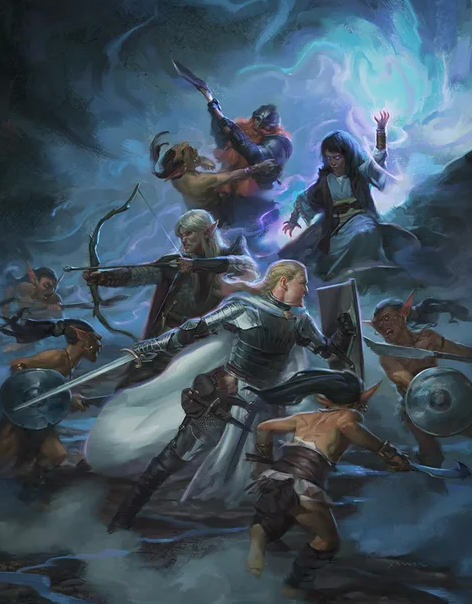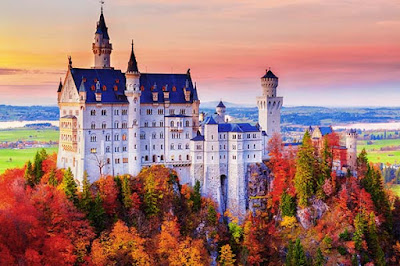Pages
Thursday, December 30, 2021
I WANT it to attack me! Defenders, marking, and cover (5e quick fix)
Tuesday, December 14, 2021
Brazilian monster sketches (Rick Troula)
Saturday, December 11, 2021
The Black Company (dark fantasy book review)
The Black Company, released in May 1984, is the first novel in Glen Cook's ongoing series, The Black Company. The book combines elements of epic fantasy and dark fantasy as it describes the dealings of an elite mercenary unit – the Black Company – with the Lady, ruler of the Northern Empire.
In Dragon magazine issue 96 (April 1985), Gary Gygax wrote this about The Black Company which is what inspired me to seek it out originally. Anyone else read this way back then?"A good “game” book If you haven’t read The Black Company by Glen Cook (Tor Books, Tom Doherty Associates, Inc., 1984), then you are missing a good book which relates closely to the AD&D® game. I can’t swear that the author plays FRP games, let alone any of TSR’s offerings, but somehow he has captured the essence of them, regardless. The Black Company reads as if it were a literary adaptation of actual adventuring, as it were, in a swords & sorcery milieu akin to that of a proper AD&D game campaign. The style of writing is neither heroic nor swashbuckling. There is none of Robert E. Howard in the book. It is a dark work. Nevertheless, it is one fine bit of fantasy authorship. I recommend it to all role-playing game enthusiasts for many reasons, not the least of which is that it will assist in proper fantasy role-playing. For $2.95 this book will provide both reading enjoyment and much support for your RPG activity. It is one you shouldn’t miss."
Friday, December 10, 2021
Table tools, booklets, and Into the Unknown
The game is divided into five digest-sized booklets, optimized for use at the gametable:
- Book 1: Characters holds all you need to quickly create a new character (52 pages)
- Book 2: Playing the Game has all the essential rules for players to get going (28 pages)
- Book 3: Magic is strictly for those players whose characters are spellcasters (54 pages)
- Book 4: Running the Game has everything a Game Master needs for running old-school games (85 pages)
- Book 5: Monsters holds a selection of ready-to-use critters, complete with morale scores and treasure types (65 pages)
These are all laid out and edited to be as quick to scan and find what you are looking for at the table as possible- no more getting bogged down by looking things up in play!
These are all Affiliate links - by using them, you're helping to support this blog!
Tuesday, November 30, 2021
Hexcrawl x Pointcrawl - when to use them
I'm not going through definitions here. Let's just say that a hexcrawl means exploring a territory that is divided by hexes, with no clear paths, and a pointcrawl means exploring a territory through preexisting paths and points of interest.

This is a typical pointcrawl map (source). You cannot make your own path; to get from Gettysburg to Grafton you must pass through Harper's Ferry.
You can have both at once (source):
Thursday, November 25, 2021
Black Friday/Cyber Monday Sale DTRPG sale
Thursday, November 18, 2021
Teratogenicon - print version now available!
TERATOGENICON - our most impressive book so far - is a collection of tables and essays on how to create your own monsters.
It contains one chapter for each of the fourteen most famous monster types (aberrations, beasts, celestials, constructs, and so on). Each chapter examines specific habits, appearance, goals, traits, powers, origins, and many other topics. In addition, the appendixes will help you to create stats (for both old school and contemporary games), to roleplay monsters, and to include all monster types into a coherent whole, among other things.
The book is beautifully illustrated by Rick Troula (of The Displaced fame). Take a look at the previews to see for yourself!
Monday, November 15, 2021
Inverse Ravenloft
Thursday, October 21, 2021
Ford's Faeries (free OSR bestiary)
A bestiary inspired by the masterful work of Henry Justice Ford.
Meet the Moon-Headed Giant, the Leechlich, and the Fencer Familiar, and more than 50 other weird creatures fit for campaigns of every level. The full-page illustrations, often taken from fairytale books, have led our 15 authors to create original monsters that will give a quirky twist to your game. They all come with enough material to become the centerpiece of the session.
Contributors: Dan D., Daniel Lofton, Dat Epic Fish, Emmy Allen, Eric Diaz, Eric Nieudan, Goblin’s Henchman, Guillaume Jentey , HD Atkinson, James V. West, Jean-Marc "Tolkraft" Choserot, Ktrey Parker, Magimax, Roger SG Sorolla, Sébastien d’Abrigeon, and Vance Atkins.
Stats are compatible with most early editions of Dave and Gary's game and their retroclones.
NOTE: none of the contributors are making any money for their writing. I (Eric Nieudan) collect a small margin (a little over a US dollar) to try and pay for the 60 or so hours spent on coordinating, editing, and layout. I'll appreciate the help if you get a copy!
Tuesday, October 19, 2021
How far can you see (in hexes)?
2. Horizon. Your average human in a flat area without any obstructions in view (think a becalmed sea) can see up to 3 miles. Thats the distance to the horizon best case scenario. So a party travelling straight through a 6 mile hex is not going to see out of it. Unless they climb a tree or find a high place with a view. But the idea is that a 6 mile hex with varied terrain covers the distance that the party can see. A good rule of thumb is that if they take the time to survey the surrounding land then a party should be able to be aware of the terrain of the next hex over. Some pushback might come with the idea that you can see a mountain quite a ways away. But mountains are tricky in that you really can't tell how far away they are until you are a few hexes away. Getting a good vantage point (like the top of a hill or mountain) could be the opportunity for adventure in itself and being aware of the lay of the land can be its own reward. If you want to be able to tell your players how far they can see when they climb up the hill or tree or tower a good rule of thumb is that the distance to the horizon is the square root of thirteen times the height they are viewing from (http://enwikipedia.org/wiki/horizon).
Thursday, October 07, 2021
Small Press Spotlight Sale - huge discounts
Tuesday, October 05, 2021
HP bloat in old-school systems
Friday, October 01, 2021
Warduke's armor and nostalgia ramblings
In addition, I have more 5e books than I need, and I don't think I'm buying new books unless they came up with a good campaign (like Curse of Strahd and Tomb of Annihilation, despite all the flaws of both products). Is The Wild Beyond the Witchlight this book? Not sure, I'll wait for more reviews.
This version by Timothy Truman is probably my favorite. The helmet looks better, IMO, and the bare chest gives him a "barbarian" (or gladiator?) look. And the short stat block is awesome... Imagine if all 8th-level fighters could be described in a similar space... the game would be a lot lighter.
Sunday, September 26, 2021
So D&D 5.5e is really coming out in 2024 (official)
"New version", "backwards compatible"... Crawford mentions that the game "is always evolving" in the video, Winniger is talking about "new versions of the core rulebooks" with feedback on existing classes... etc.
Saturday, September 25, 2021
"Race requirements" (B/X) might be the best mechanic for fantasy "races"
Thursday, September 23, 2021
The Curse of BloodStone Isle (5e dark fantasy Kickstarter by Mark Rein-Hagen)
Saturday, September 18, 2021
Should monsters "know what they're doing"?
When a corpse flower is seriously wounded (reduced to 50 hp or fewer), its self-preservation impulse kicks in to tell it that it’s not going to survive just by digesting its corpse collection. Lacking the Intelligence to Disengage, it Dashes away in whichever direction it senses the fewest enemies in.
(Bone knight)
Their Charisma is high enough that an encounter will probably involve some measure of parley, and maybe only parley—they understand, after all, that it’s better to get what you want without fighting if you can—but their social skill proficiencies are in Intimidation and Deception, so we’re not talking about good-faith negotiation here. Instead, this combination suggests to me that they’re about trying to get their opponents to capitulate, through a combination of outright bullying and more subtle manipulation. Any rhetorical maneuver an abuser might use is right up the bone knight’s alley: direct and indirect threats; negative reinforcement; false accusations; gaslighting; DARVO; demonstrations of explosive anger and sudden, unpredictable violence; dividing enemies by singling out individuals among them for particular blame; and so on.
Each monster has its own capacities, knowledge andgoals. Most monsters know nothing about the charactersand their powers, even if the GM does. Do not fall into thetrap of assuming the monster will always come to the rightconclusions. “The old guy with a staff is probably a sorcerer”should be an uncommon line of thought – instead, he ismost likely someone that needs a walking aid, at least untilhe casts a spell. A huge fighter with a sword, on the otherhand, is clearly someone you should watch.Once the player characters start fighting and using theirabilities, some things will become obvious, and monsterswill react accordingly. Still, most monsters will not be ableto see the whole picture at once. One easy way to dealingwith this is assuming most monsters will attack whoeverhurt them most (individually, not as a group) since their lastturn, unless they have an obvious reason to do otherwise.A good leader or tactician can change everything – hecan order the other monsters to work as a group, makingthe best choices for their side even if he needs to sacrificea soldier or two. A good plan will make monsters tentimes more dangerous, at least until it is derailed. A carefulstudy of the PCs tactics will give the monsters an edge(and vice-versa).
In short, play monsters not as pawns, but as individuals.Intelligent, experienced monsters will fight intelligently,bestial monsters will fight instinctively, and stupid monsterswill often make dumb mistakes.
Tuesday, September 14, 2021
5e quick fix: classes
If you want to take a look or comment on it, I'll often be talking about it here in the blog, but I've also started a thread in the GitP forum. Feel free to participate!
5e is a decent enough game. Probably my second-favorite version of D&D. I get the feeling that the "fixes" it needs are minimal. So, instead of writing a minimalist version of 5e, maybe I should just use 5e with house rules? Or, as I call them, "quick fixes"? We'll see. I'm currently playing Shadow of the Demon Lord and I like it. But D&D still has something enticing for me.
Anyway, here are some small fixes, for example, that I'd add to existing classes.


























